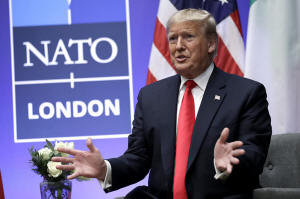Trump heads to the NATO summit on the heels of a possible Israel-Iran
ceasefire
[June 24, 2025]
By SEUNG MIN KIM
WASHINGTON (AP) — President Donald Trump’s first appearance at NATO
since returning to the White House was supposed to center on how the
U.S. secured a historic military spending pledge from others in the
defensive alliance — effectively bending it to its will.
But in the spotlight instead now is Trump’s decision to strike three
nuclear enrichment facilities in Iran that the administration says
eroded Tehran’s nuclear ambitions as well as the president's sudden
announcement that Israel and Iran had reached a “complete and total
ceasefire.” The sharp U-turn in hostilities just hours before he was set
to depart for the summit is sure to dominate the discussions in The
Hague, Netherlands.
The impact of the strikes had already begun to shape the summit, with
NATO Secretary-General Mark Rutte dancing around the issue even as
hundreds of people showed up in The Hague on Sunday to denounce the
conflict in a protest that was supposed to be focused on defense
spending.
Still, other NATO countries have become accustomed to the unpredictable
when it comes to Trump, who has made no secret of his disdain for the
alliance, which was created as a bulwark against threats from the former
Soviet Union.
Trump’s debut on the NATO stage at the 2017 summit was perhaps most
remembered by his shove of Dusko Markovic, the prime minister of
Montenegro, as the U.S. president jostled toward the front of the pack
of world leaders during a NATO headquarters tour.

And he began the 2018 summit by questioning the value of the decades-old
military alliance and accusing its members of not contributing enough
money for their defense — themes he has echoed since. In Brussels, Trump
floated a 4% target of defense spending as a percentage of a country's
gross domestic product, a figure that seemed unthinkable at the time.
Sen. Jeanne Shaheen of New Hampshire, the top Democrat on the Senate
Foreign Relations Committee, will also attend the NATO summit this week.
She said if Trump does anything to sow division within the alliance, it
would benefit Xi Jinping of China, which NATO countries have accused of
enabling Russia as it invades Ukraine.
“That does not help America, does not help our national security,”
Shaheen said in an interview. “What it does is hand a victory to our
adversaries, and for an administration that claims to be so concerned
about the threat from (China), to behave in that way is hard to
understand.”
Trump heavily telegraphed his attitude toward global alliances during
his presidential campaigns.
As a candidate in 2016, Trump suggested that he as president would not
necessarily heed the alliance’s mutual defense guarantees outlined in
Article 5 of the NATO treaty. And during a campaign rally in 2024, Trump
recounted a conversation with another NATO leader during which Trump
said he would “encourage” Russia “to do whatever the hell they want” to
members who weren’t meeting the alliance’s military spending targets.
In The Hague, Trump will want to tout — and take credit for — the pledge
to hike military spending, which requires other NATO countries to invest
in their defense at an unprecedented scale.
The president went as far as to argue that the U.S. should not have to
abide by the 5% spending pledge he wants imposed on the other NATO
countries.
That 5% is effectively divided into two parts. The first, 3.5%, is meant
to be made up of traditional military spending such as tanks, warplanes
and air defense. What can comprise the remaining 1.5% is a bit fuzzier,
but it can include things like roads and bridges that troops could use
to travel. According to NATO, the U.S. was spending about 3.4% of its
gross domestic product on defense as of 2024.
[to top of second column]
|

President Donald Trump speaks during the NATO summit, Dec. 4, 2019,
in Watford, England. (AP Photo/ Evan Vucci, File)

Most NATO countries — with Spain as the key holdout — are preparing
to endorse the pledge, motivated not just by Russian President
Vladimir Putin’s invasion of Ukraine to bolster their own defenses
but also perhaps appease the United States and its tempestuous
leader.
“He hasn’t said this in a while, but there are still a lot of
worries in Europe that maybe the United States will pull out of
NATO, maybe the United States won’t honor Article 5,” said Matthew
Kroenig, vice president and senior director of the Atlantic
Council’s Scowcroft Center for Strategy and Security and a former
Pentagon official. “I think there is a real fear among Europeans
that we need to deliver for Trump in order to keep the United States
engaged in NATO.”
Kroenig added: “Like it or not, I do think Trump’s tougher style
does get more results.”
European allies have taken note of potential signs of a broader U.S.
retreat. France and other NATO countries have been concerned that
the Trump administration is considering reducing troop levels in
Europe and shift them over to the Indo-Pacific, which Cabinet
officials have signaled is a higher priority.
Still, Secretary of State Marco Rubio and U.S. Ambassador to NATO
Matt Whitaker have underscored the U.S.’ commitment and have said
the Trump administration is only seeking a stronger alliance.
“There’s sort of — in some ways — not a coherent view coming from
this administration, the Trump administration, about how it sees
NATO,” said Max Bergmann, the director of the Europe, Russia and
Eurasia program at the Center for Strategic and International
Studies. “And right now, Europeans can kind of see what they want
from the United States.”
The White House has not said which world leaders Trump will meet
with at the World Forum in The Hague. It’s unclear whether Trump’s
path will cross with Ukrainian President Volodymyr Zelenskyy’s; the
two leaders were scheduled to meet at the Group of 7 summit in
Kananaskis, Alberta, earlier this month before Trump abruptly cut
his trip short and returned to Washington.

Rutte has stressed before that Trump’s tariff war has no impact on
NATO since the alliance doesn’t deal with trade. But it will be hard
to ignore the issue as the U.S. and the European Union continue to
negotiate a trade deal after the U.S. president threatened 50%
import taxes on all European goods.
Trump has set a July 9 deadline for the U.S. and the 27-country EU
to strike a trade deal. But in recent days, he’s said the EU had not
offered a fair deal as he reiterated his threat to force Europe to
“just pay whatever we say they have to pay.”
___
Associated Press writer Mike Corder in The Hague, Netherlands,
contributed to this report.
All contents © copyright 2025 Associated Press. All rights reserved
 |